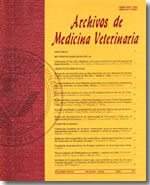Determination of potential risk of heat stress of cattle in four locations of Central and Southern Chile
Main Article Content
Abstract
Meteorological data from December to January of years 1999 to 2007 from weather stations located in four localities in Chile (Curicó, Chillán, Temuco and Osorno) were used to calculate the adjusted temperature-humidity index (THIadj-max). Climate variables used to calculate the index were: wind speed, air temperature, relative humidity and an estimated value of solar radiation. When the values of THIadj-max were greater than 75, those days were considered as "alert" and as potential risk of heat stress in cattle. Additionally, the impact of climate on animal production was assessed by means of potential losses in milk production for each locality estimated by two equations. The localities of Curicó and Chillán presented similar values of THIadj-max (79.4 and 79.1, respectively), and both were higher than those for Temuco and Osorno (77.1 and 68.1, respectively, P < 0.05). The probability of days with mean THIadj-max > 75 was greater in the Central region. In addition, the estimated mean milk production loss was greater in the Central regions (1.5 to 4.3 and 1.2 to 3.1 L*cow-1*d-1 for Curicó and Chillán, respectively). Conversely, the Southern regions, Temuco and Osorno, presented lower potential losses with 0.9 to 2.6 and 0.1 to 0.6 L*cow-1*d-1, respectively. In conclusion, the potential risk of heat stress of cattle seems greater in Curicó and Chillán, moderate in Temuco and minimum in Osorno. Additional research is needed in the order to quantify the impacts of environmental conditions in productivity and welfare of cattle in Chile.

